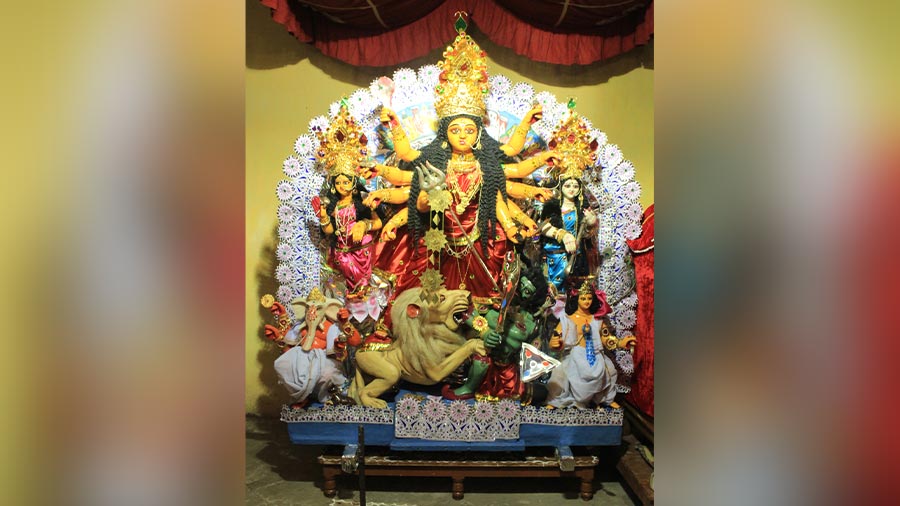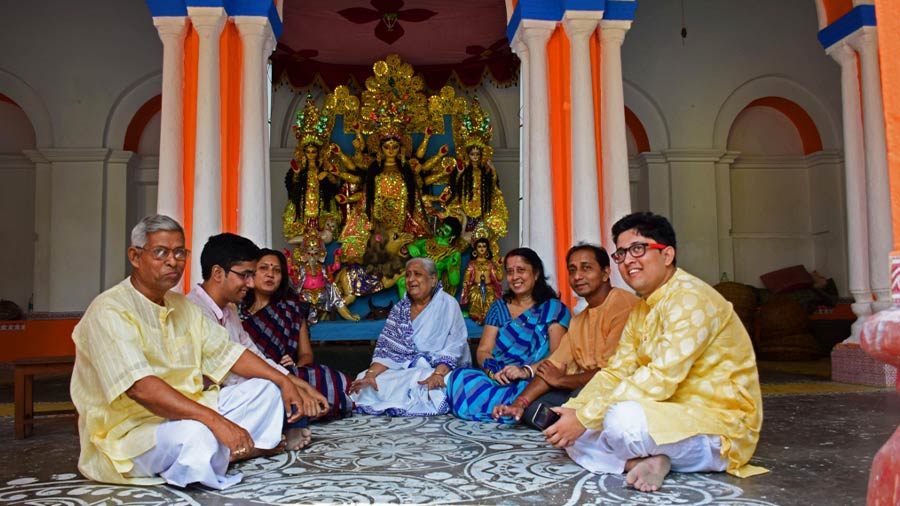It is indeed a rare sight when goddess Durga comes accompanied by a tiger along with her usual vahan, the lion. To witness the unusual idol, one may visit the Durga Puja of the Mustafi family in Dinhata, Cooch Behar.
The 356-year-old puja, one of the oldest in Cooch Behar, is conducted in keeping with the Matsyapuran and the puja rituals are conducted as per the Talpatar Punthi (scripture written on pages of palm leaves). The Dinhata Mustafi family puja has changed places thrice but the family rituals still continue.

The Devi’s ‘bodhon’ takes place under a dedicated bel tree on Sasthi
Bodhon is conducted near a dedicated bael tree on Sashthi, followed by adhibas. A pot of milk with banana is kept as an offering to Nag devata. This is part of the Manasa Devi (goddess of snakes) cult in the area.
Before the goddess is instituted in her place of worship inside a dedicated temple, a sarvatobhadra mandal is drawn there. It is a circular diagram, which is considered auspicious and is supposed to ensure welfare. The structure of sarvatobhadra mandal starts with a square drawing. Then, two equal lines are drawn from south to north and from the west to the east and ultimately 256 squares are created. Then five items — powder from dried bel leaves, burnt chaff of paddy (dhaaner tush), aatop rice, turmeric and abir were placed on these squares.
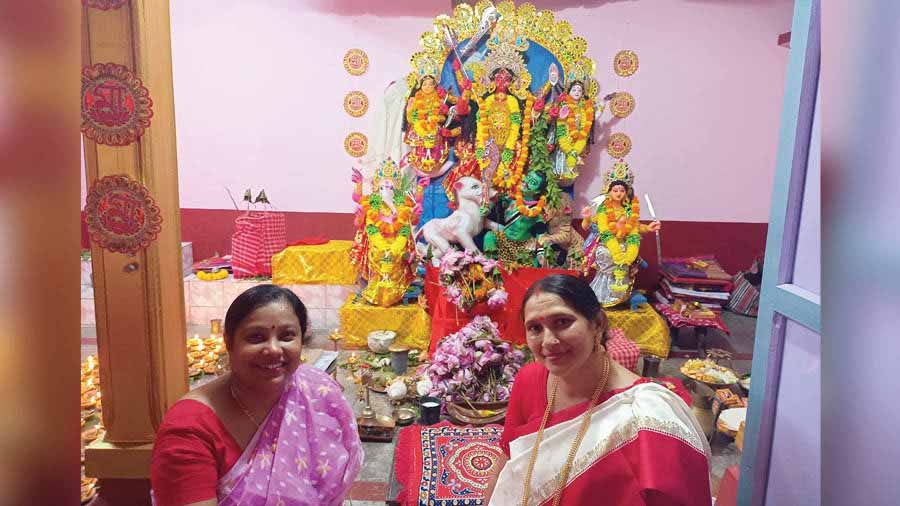
Women do not not participate in any rituals inside the temple sanctum during Durga Puja
The goddess has a dark red complexion and is draped in a glazing red saree, adorned with silver jewellery. Interestingly, Durga with Saraswati dressed in white and Lakshmi in red is under the chalchitra, while Kartick and Ganesh stand outside it. The lion is white and looks like a horse and is accompanied by a tiger in attacking Mahishasur. Interestingly, the other such instance can be seen in the Cooch Behar Rajbari Durga Puja although in that puja, only Jaya and Bijoya accompany the goddess. The look and feel are different, too.
Nabapatrika rituals take place inside the premises of the Mustafi family. After the bathing rituals, the nabapatrika is draped in a white saree with a red border.
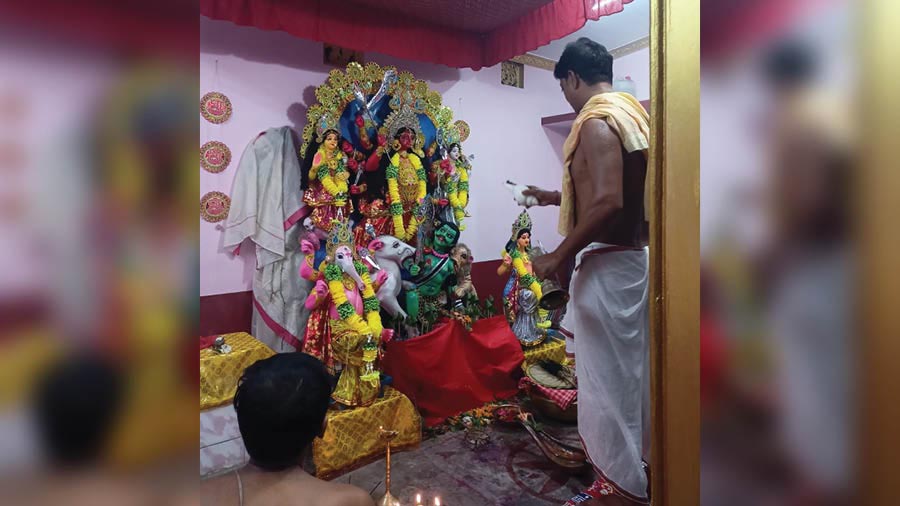
The Dinhata Mustafi family Durga Puja is one of the oldest family-run Durga Pujas of Cooch Behar
Sitangshu Shekhar Mustafi, a senior member of the family, said: “In 1665, Rupchandra Narayan Majumdar, the initiator of this puja, came to the Cooch Behar state from the Nawab Darbar of Dacca at the request of King Madannarayan alias Mad Narayan (reign between 1665 and 1680) of Cooch Behar. After reaching Cooch Behar, Rupchandra left his titular surname Majumder and accepted the title ‘Mustafi’ provided by the king of Cooch Behar. Initially, he settled at Bhitarkuthi village near the border of Bangladesh. This puja started at Bhitarkuthi from 1665. Later, the family shifted to Gobrachara Chota Folimari village. Puja was conducted in the Durga Mandir and dalan which was built at Gobrachara. After that, a major part of the family members shifted to a house at Godhulibazar in ward number 6 of Dinhata town. Since then, the puja continues there. Though the place of worship has changed multiple times, there has been no interruption in the major ancient customs.”

The Mustafis originally had their surname Mukherjee when they stayed at Tribeni, Hooghly, before moving to Dacca, and thus being Brahmin, they provide annabhog to their goddess. There is a ritual of animal sacrifice too. Goat and even pigeons are sacrificed on Saptami, Ashtami and Navami. There is a specific ritual of offering sherbet of mishri (rock sugar) to the goddess after each sacrifice.
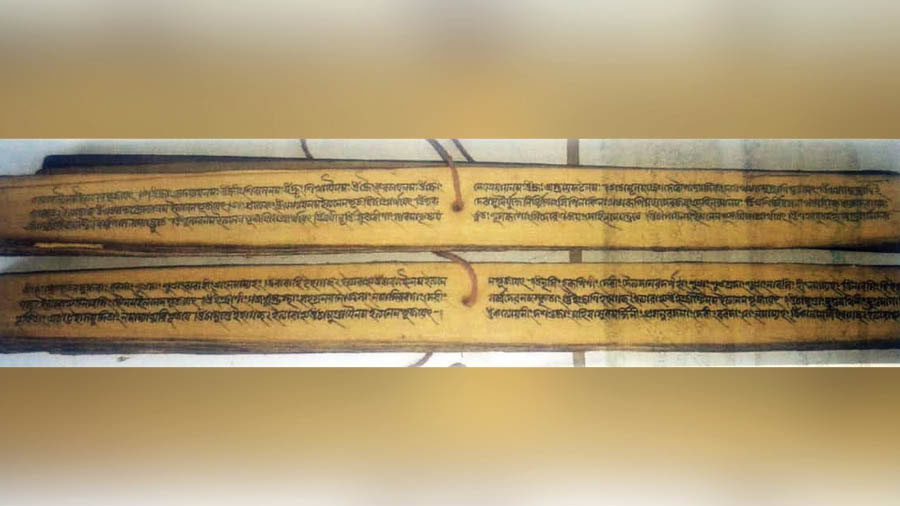
The entire Puja is conducted as per rituals mentioned in a ‘Talpatar Punthi’ (in pic)
Main bhog items include rice with ghee, khichuri, vegetable curry, fish curry of either boal or shol fish, cooked sacrificial meat, payesh (dessert made of rice and milk), chutney of either alubukhara, chalta or tamarind. On Saptami, the payesh has add-ons of sugar and batasha, on Ashtami it is mishri (rock sugar) and Navami it is same as Saptami, only honey is added as an extra ingredient. On Sandhi Puja, the goddess is offered a menu strictly without rice which contains luchi, sujir payesh and other sweets. On Dashami, the goddess is offered panta bhaat and milk. A dish of chuno maachh (small fish) is dedicated to the goddess and kept at one side. Interestingly, it is not offered to the goddess as bhog.
Once upon a time on the late night of Mahashtami puja of the Dinhata Mustafi family, a gupto puja or secret puja used to take place when no family member was supposed to be present. However, in the present day, everyone remains present during Ashtami pujo and specially during Sandhi Puja to light the 108 earthen lamps. Interestingly, womenfolk of the family do not take part in any ritual performed in the inner sanctum of the temple where Durga is being worshipped.

The Sandhi Puja takes place with 108 earthen lamps being lit
On Dashami, after the rituals of Darpan Bisarjan, Aparajita puja is performed as well as the weapons of the goddess are worshipped. After the Aparajita puja, offered doob grass, mustard seeds, grains of aatop rice and stem of Aparajita flower are tied together with small white cloths soaked in turmeric on the forearm of family members. The goddess is immersed in a nearby pond. Sindur khela is a non-glamorous ritual in the Dinhata Mustafi family.

